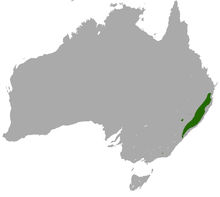Brush-tailed rock-wallaby
| Brush-tailed rock-wallaby[1] | |
|---|---|
| | |
| Scientific classification | |
| Kingdom: | Animalia |
| Phylum: | Chordata |
| Class: | Mammalia |
| Subclass: | Marsupialia |
| Order: | Diprotodontia |
| Family: | Macropodidae |
| Genus: | Petrogale |
| Species: | P. penicillata |
| Binomial name | |
| Petrogale penicillata (Gray, 1827) | |
 | |
| Brush-tailed rock-wallaby range | |
The brush-tailed rock-wallaby or small-eared rock-wallaby (Petrogale penicillata) is a kind of wallaby, one of several rock-wallabies in the genus Petrogale. It inhabits rock piles and cliff lines along the Great Dividing Range from about 100 km north-west of Brisbane to northern Victoria, in vegetation ranging from rainforest to dry sclerophyl forests. Populations have declined seriously in the south and west of its range, but it remains locally common in northern New South Wales and southern Queensland.[3]
Introductions
As part of the acclimatisation movement of the late 1800s, governor Grey introduced this and four other species of wallabies (including the rare parma wallaby) to islands in Hauraki Gulf, near Auckland, New Zealand, where they became well-established. In modern times, these populations have come to be viewed as exotic pests, with severe impacts on the indigenous flora and fauna. As a result, eradication is being undertaken, after initial protection for review of their Australian populations and the return of some wallabies to Australia. Between 1967 and 1975, 210 rock-wallabies were captured on Kawau Island and returned to Australia, along with thousands of other wallabies.[4] Rock-wallabies were removed from Rangitoto and Motutapu Islands during the 1990s, and eradication is now underway on Kawau. Another thirty-three rock-wallabies were captured on Kawau during the 2000s, and returned to Australia, before eradication began.[5][6]
In 2003 some Kawau brush-tails were relocated to the Waterfall Springs Conservation Park north of Sydney, New South Wales, for captive breeding purposes.
Due to an escape of a pair in 1916, a small breeding population of the brush-tailed rock-wallabies also exists on the island of Oahu in Hawaii.
Attempts at reintroduction into the Grampians National Park during 2008-12 were not successful, largely due to fox predation.[7]
References
- ↑ Groves, C.P. (2005). Wilson, D.E.; Reeder, D.M., eds. Mammal Species of the World: A Taxonomic and Geographic Reference (3rd ed.). Baltimore: Johns Hopkins University Press. p. 68. OCLC 62265494. ISBN 0-801-88221-4.
- ↑ Woinarski, J.; Burbidge, A.A. (2016). "Petrogale penicillata". IUCN Red List of Threatened Species. Version 2016. International Union for Conservation of Nature. Retrieved 7 November 2016.
- ↑ A Field Guide to the Mammals of Australia, Menkhorst, P and Knight, F, Oxford University Press, Melbourne, 2001 ISBN 0-19-550870-X
- ↑ Shaw, W.B.; Pierce, R.J. 2002: Management of North Island weka and wallabies on Kawau Island. Department of Conservation Science Internal Series 54. Department of Conservation, Wellington. ISBN 0-478-22272-6.
- ↑ "Rock wallabies". Catalyst. ABC. 4 March 2004. Retrieved 2 March 2012.
- ↑ "Saving the Brush-tailed Rock Wallaby". Waterfall Springs Wildlife Sanctuary. Retrieved 2 March 2012.
- ↑ Taggart, D.A.; Schultz, D.J.; Corrigan, T.C.; Schultz, T.J.; Stevens, M.; Panther, D.; White, C.R. (2016). "Reintroduction methods and a review of mortality in the brush-tailed rock-wallaby, Grampians National Park, Australia". Australian Journal of Zoology. 63 (6): 383–397. doi:10.1071/ZO15029.
External links
| Wikimedia Commons has media related to Brush-tailed Rock-wallaby. |
- Brush-tailed rock-wallaby recovery in NSW (Foundation for National Parks & Wildlife)
- Brush-tailed rock-wallaby population in Green Gully - a conservation case study
- Brush-tailed rock-wallaby habitat modelling
- BBC video of brush-tailed rock-wallabies in action
